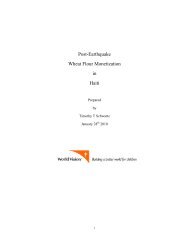CNSA Targeting
You also want an ePaper? Increase the reach of your titles
YUMPU automatically turns print PDFs into web optimized ePapers that Google loves.
31<br />
Figure 23: Income per Decile: Metropolitan vs. Provincial Urban vs. Rural<br />
(Verner 2008: 201, using HLCS 2001)<br />
Beneficiary Unit in Haiti<br />
As seen earlier, Beneficiary Units can be conceptualized as 1) “intermediary” —those institutions<br />
selected as distribution channels for reaching the intended beneficiaries--and 2) “primary”—the<br />
intended beneficiaries or groups of beneficiaries. With respect to intermediary beneficiary units,<br />
the most obvious best candidates are health organizations and schools. In the course of their work,<br />
health extension agents come into contact with the ill and malnourished making them the best<br />
situated to identify individuals and families in greatest need. However, what we found during the<br />
course of the research is that health administrators view the task of targeting as an interference<br />
with health extension work. Record keeping and tasks associated with monitoring and evaluation<br />
take up an inordinate amount of the agents’ time. Handling food draws the attention of the<br />
population and results in demands and pestering. It also incites corruption among the staff. Most<br />
health extension functionaries felt their role should be limited to making referrals to food<br />
distribution agencies.<br />
Although the most frequent means of targeting vulnerable children, the use of schools as<br />
intermediary beneficiary units has significant drawbacks as well. Not least of all, they miss the<br />
poorest children. Many low income schools lack the infrastructure needed to store the aid; and<br />
they lack the capacity to meet the accounting requirements that the NGO, WFP and USAID<br />
distributors demand of them. The consequence is that precisely those schools most likely to harbor<br />
the poorest children—i.e. the poorest schools—are not entrusted to handle food relief. Moreover,<br />
the poorest families cannot afford to send their children to school at all. The ENSA (2011) found<br />
that 10% of children 6 to 14 years of age had never been to school; another 7% did not go regularly.<br />
Associations are another frequently used intermediary Beneficiary Unit and also a type of<br />
beneficiary selector option as discussed in section on Community Based <strong>Targeting</strong>. The principal<br />
problem is that the most vulnerable individuals typically do not obtain representation in<br />
associations. The associations tend to be politicized and prioritize their own members as
















